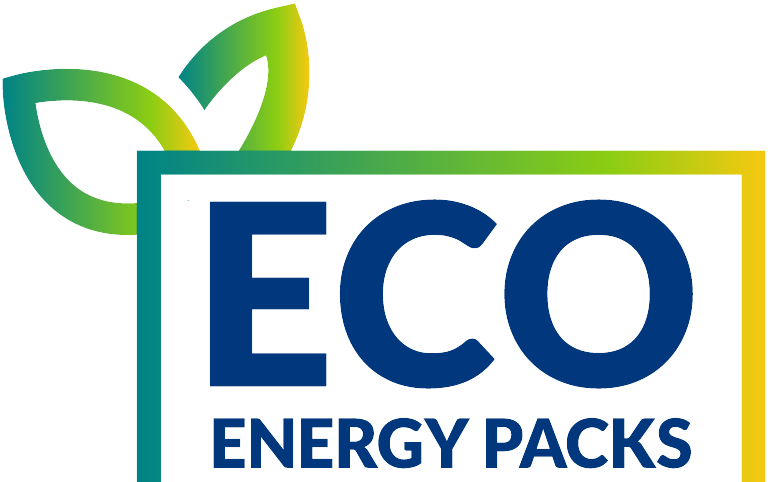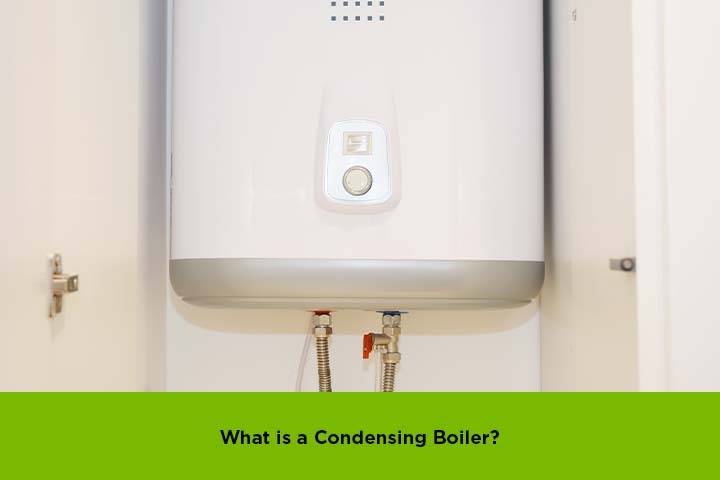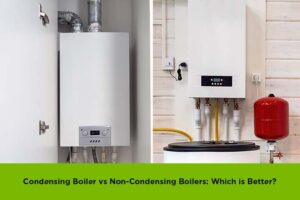A condensing boiler is a very efficient new boiler that recovers and reuses heat from waste gases which would otherwise go to waste. These cutting-edge heating appliances are engineered to recover as much energy from the fuel that they combust as possible, thus making them the most energy-efficient boiler technology used today.
How Does a Condensing Boiler Work
Condensing boilers work on a high-tech two-stage heat recovery mechanism that differentiates them from conventional boilers. When the boiler combusts fuel (usually natural gas or oil), it releases hot exhaust flue gases with water vapour. The mechanism goes like this:
- Primary Heat Exchange: The initial combustion process heats water through the primary heat exchanger, similar to conventional boilers. This heated water is then circulated through your radiators or underfloor heating system.
- Secondary Heat Recovery: The innovation is in the secondary heat exchanger, which recovers heat from the flue gases prior to their discharge through the boiler. These hot gases at temperatures of about 130°C are brought down to a temperature of about 50°C, and in the process, the water vapour condenses into liquid form.
- Heat Recycling: As the water vapour condenses, it gives off latent heat, which is employed to preheat the cold water coming back from your heating system. This reduces considerably the energy needed to raise the water back up to temperature, enhancing overall efficiency.
- Condensate Drainage: The water that has been condensed (condensate) is very slightly acidic with a pH level of 3-5 and therefore needs to be drained off through an approved drainage system. Condensate is normally neutralised before it enters the main drainage system.
Condensing Boilers vs Non-Condensing Boilers
The main difference between condensing and non-condensing boilers is how efficiently they can recover heat and their overall efficiency.
- Efficiency Comparison: Condensing boilers have efficiency ratings of 90-95%, with more recent models reaching as high as 98% efficiency. Non-condensing boilers, on the other hand, only manage 70-80% efficiency, while older designs may do even less at 50-60%.
- Heat Exchanger Design: Non-condensing boilers only employ one heat exchanger, which allows lost heat to pass through the flue. Condensing boilers either have a larger heat exchanger or a second heat exchanger in order to recover this lost energy.
- Flue Gas Temperature: Non-condensing boilers emit flue gases as hot as 250°C, which is a sizable loss of heat. Condensing boilers condense these flues to approximately 55°C, which shows their better ability to recover heat.
- Legal Status: From April 2005, all newly fitted gas boilers in UK homes have to be condensing boilers legally, with oil boilers taking up this requirement from April 2007. Installation of non-condensing boilers is permitted only in rare situations where an authorized engineer finds a condensing boiler inconvenient.
Difference Between a Condensing Boiler and a Combi Boiler
Most owners are perplexed about the difference between combi boilers and condensing boilers, but the response is simple: one is actually the other in the fact that all new combi boilers are condensing boilers.
- Technology vs Type: “Condensing” is the heat recovery technology employed by the boiler, whereas “combi” or combination represents the boiler’s ability to deliver both heating and hot water from the same unit. All the boilers made now, either combi, system, or regular boilers, have condensing technology.
- Historical Background: Prior to 2005, combi and condensing technologies existed independently, so older houses may have had either a combi boiler or a condensing boiler but not both. Current boilers now integrate both technologies and hence are condensing combi boilers.
What is a Non-Condensing Boiler?
A non-condensing boiler is an older, inefficient heating system wasting lots of heat via its single heat exchanger design. The older type, these boilers were the norm prior to the introduction of condensing technology being made compulsory in the UK.
- Design Limitations: Non-condensing boilers have just one heat exchanger, so the heat in exhaust gases is released straight through the flue without any recovery. This causes a lot of energy to be wasted and greater fuel consumption.
- Safety Aspects: In contrast to current condensing boilers which are room-sealed, non-condensing boilers usually take air from inside the house for ventilation. This is a design constraint and prevents them from being installed in bedrooms and is more dangerous.
- Availability Now: Although non-condensing boilers are largely banned under UK building codes, their installation may be permitted in exceptional situations where a qualified Gas Safe engineer concludes that an installation of a condensing boiler is impracticable.
Do I Need a Water Tank with a Condensing Boiler?
Whether you need a water tank with a condensing boiler is entirely up to the boiler system you install, rather than the condensing technology.
- Combi Condensing Boilers: These compact units do not need a dedicated water tank since they heat water on demand directly from the mains supply. These are best suited for smaller houses where space is limited.
- System Condensing Boilers: These boilers need a hot water cylinder to hold warm water but not a cold water tank in the loft. They use water straight from the mains supply similar to combi boilers but retain it for future use.
- Regular Condensing Boilers: They are also referred to as conventional boilers and need a hot water cylinder and cold water storage tank, often in the loft. They are typically seen in older homes with existing tank setups.
Vaillant Condensing Boiler
Vaillant is a top boiler manufacturer of condensing boilers, with a wide variety of models catering to homes of varying sizes and needs.
- ecoTEC Range: Vaillant’s top-of-the-range ecoTEC line comprises the Pro, Plus, and sustain models with outputs between 19kW and 120kW. They come equipped with state-of-the-art technology like the aquaCOMFORT feature for quick water supply and suitability with renewable energy systems.
- ecoFIT Series: The ecoFIT pure and sustain products provide ultra-compact models with efficiency ratings of up to 94%. ecoFIT boilers are hand-assembled in Vaillant’s award-winning Derbyshire factory and incorporate automotive-grade aluminium heat exchangers.
- Performance Specifications: Vaillant boilers come with 93-94% efficiency ratings and ErP A-ratings for both hot water and heating. Some models such as the ecoTEC Pro 30 have central heating outputs of 25.7kW and hot water outputs of 30kW for homes with 10 radiators and between 1-2 bathrooms.
The Final Thoughts
Gas condensing boilers are the most prevalent form of condensing boiler in the UK, using natural gas as their main source of fuel.
Fuel Efficiency: New gas condensing boilers have AFUE ratings of 90% or better, and high-end models can be as efficient as 95-98%. This is to say that 90-98% of the fuel’s energy is utilized to heat your home.
Environmental Benefits: Through maximising fuel efficiency, gas condensing boilers hugely minimize carbon emissions from the environment as compared to non-condensing older models. A standard replacement can save up to 1,220kg of carbon dioxide every year while lowering heating bills by hundreds of pounds every year.
Installation Requirements: Gas condensing boilers should be fitted by a Gas Safe registered engineer and must have suitable condensate drainage, correct flue terminals, and sufficient ventilation. The condensate pipe should comply with certain requirements, such as a minimum internal diameter of 30mm and correct insulation for runs outside the boiler.
FAQs
Condensing boilers can cut energy use by as much as 30% over conventional boilers. Based on how efficient your old boiler was, you may save up to £350 a year in heating costs if you replace it with a new condensing boiler. Your actual savings will vary depending on the age of your existing system and its efficiency rating.
Condensing boilers must be serviced every year by a trained specialist, just like other types of boilers. The main variation is that specific work must be done on the heat exchanger and the condensate traps in servicing. Regular maintenance guarantees peak efficiency and keeps the condensate drainage system free from faults.
Yes, condensing boilers can be used with existing radiator systems, although they function best when the return water temperature is approximately 55°C or less. For best condensing efficiency, big radiators or underflooring systems can be advantageous, but typical radiators will function just fine.
Condensate pipes can freeze in low temperatures, which may lead to the boiler shutting down as a protective measure. To avoid this, external condensate pipes must be insulated, use a minimum of 32mm diameter, and be kept as short as possible (ideally under 3 metres). Internal drainage connections are ideal where feasible.
Though condensing boilers can cost a bit more in the initial installation because of added components such as secondary heat exchangers and condensate drainage systems, the installation fees are relatively similar to other contemporary boilers. Long-term energy savings generally pay for any increased initial investment after a few years, so they are cost-saving options for most homeowners







